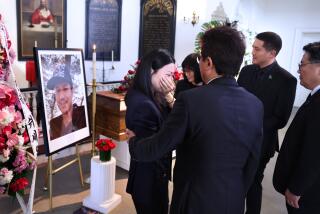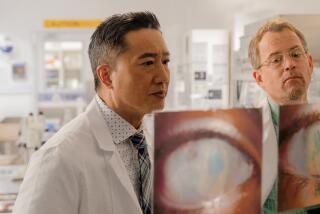Drive Launched for Minority Donors of Vital Bone Marrow
- Share via
Richard Wong, a 16-year-old Cerritos teen-ager who likes math and pizza, has two strikes against him. He has aplastic anemia, a potentially fatal blood disease. And, simply because he is Asian, his chances of finding a cure are slim.
A bone marrow transplant might be needed to save his life, but Wong’s sister, mother and father have been tested and their blood and tissue characteristics are not the same as Richard’s.
Wong’s only hope for finding a donor is the constantly expanding list of volunteers kept by the National Marrow Donor Program, a federally funded registry based in St. Paul, Minn.
Finding a match almost always means finding a donor of the same race, because people of the same race have a greater similarity of tissue makeup.
For whites, the chances of finding a match among the 300,000 on the registry are 1 in 4. For Wong and other minorities, the odds are far higher--about 1 in 20,000 because less than 10% of all the names on the registry are minorities--Asians, Latinos, African-Americans or American Indians.
Last spring, year-old Amanda Chiang of Sacramento died of leukemia after a media blitz conducted by her family failed to produce a compatible donor. In South-Central Los Angeles last year, a community-based drive did not turn up a compatible donor in time to save 11-year-old William Rall, who was black.
“It’s bleak, very bleak (for minorities),” said Liz Quam of the marrow donor program.
Earlier this month, the marrow donor program launched a drive to recruit minority donors, using celebrities such as Blair Underwood of TV’s “L.A. Law” and locations such as 7-Eleven stores in minority neighborhoods.
To improve Wong’s odds, his family and the staff and students at Cerritos High School, where he is a sophomore, have launched a campaign throughout the Southland to recruit Asian donors.
“I’m doing this for other people, too,” said Wong’s publicity-shy mother, Susan, a Kaiser Hospital nurse.
It is difficult for the family to go public with a plea, she said, but it helps to know that the name of everyone tested on her son’s behalf will be put on the national registry and may be matched to another patient. There are currently 150 Asians throughout the nation seeking compatible donors, said Tami Brown, general manager of the National Marrow Donor Program’s western regional office in Covina.
In Cerritos, the high school students are circulating flyers among the city’s many Asian groups. Stories about Richard are being published in Asian-language newspapers in Los Angeles County and, on May 5, the Red Cross and the marrow donor program will conduct testing at Cerritos High School.
Potential donors must be between 18 and 55 years old. The testing procedure is just like donating blood. About two tablespoons are needed to type the six leukocyte antigens found in human blood.
Extracting bone marrow is a relatively simple medical procedure, not nearly as complicated as donating a body organ. If a volunteer donor is compatible with a patient in need of a marrow transplant, a small amount of the red, jelly-like fluid is scooped out of the donor’s bones. The marrow quickly replaces itself and the chances of a total cure in the case of aplastic anemia are as high as 80%.
Wong has been getting medication and blood transfusions for his aplastic anemia for about three months and has shown little improvement, his mother said. Doctors at the City of Hope in Duarte, where the bone marrow transplant would be conducted, have advised Wong and her husband, Frederick, to begin searching for a donor.
There are cultural barriers, however, to recruiting Asians as donors, said Susan Wong. “They’re scared,” she said. “That’s why American people are the ones that always volunteer. Asians are scared of everything that has to do with medical stuff.”
During the campaign for Amanda Chiang, her parents concentrated on recruiting young Asian parents such as themselves. Many older Asians were too superstitious to participate, believing that they would lose their souls if they had any kind of a transplant.
“We have to explain (to Asians) how the procedure works and that it is safe,” Susan Wong said.
Richard Wong is confident that he’ll recover one way or the other. Like his mother, he stresses that the campaign on his behalf will actually help many other patients. “If I get better,” he said, “I’ll donate mine. I’ll sign up.”
The cheerful teen-ager doesn’t complain about the symptoms of the disease, which robs his system of red blood cells and leaves him weak and dizzy.
Spending as much time in hospital labs as he has in the past three months has taught Richard something else--that he is fascinated with medical technology and he has begun thinking about a career in that field.
Right now, however, he is concentrating on more immediate things--such as when he’ll be able to play basketball with his buddies again. “I’ll go through any pain as long as I know I’ll get better,” he said.
NEXT STEP
* People wishing to volunteer for the National Marrow Donor Program can be tested free between noon and 4 p.m. May 5 at Cerritos High School, 12500 E. 183rd St., Cerritos.
Participants must be between the ages of 18 and 55, and in excellent health. The testing is being sponsored by the national program and the American Red Cross.
More to Read
Sign up for Essential California
The most important California stories and recommendations in your inbox every morning.
You may occasionally receive promotional content from the Los Angeles Times.













